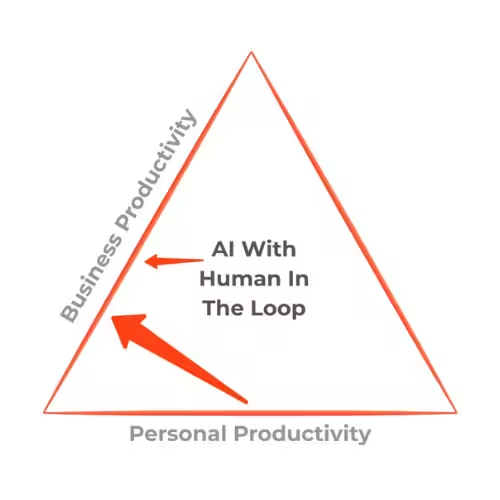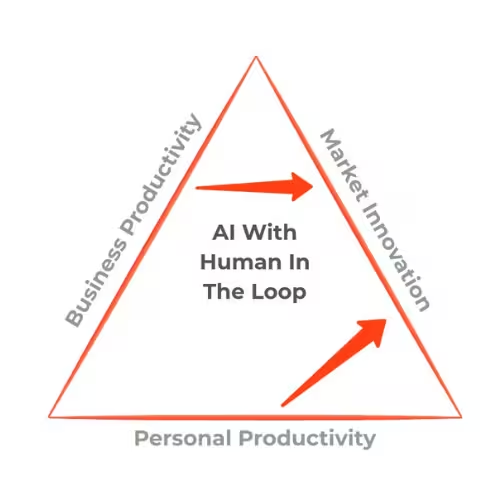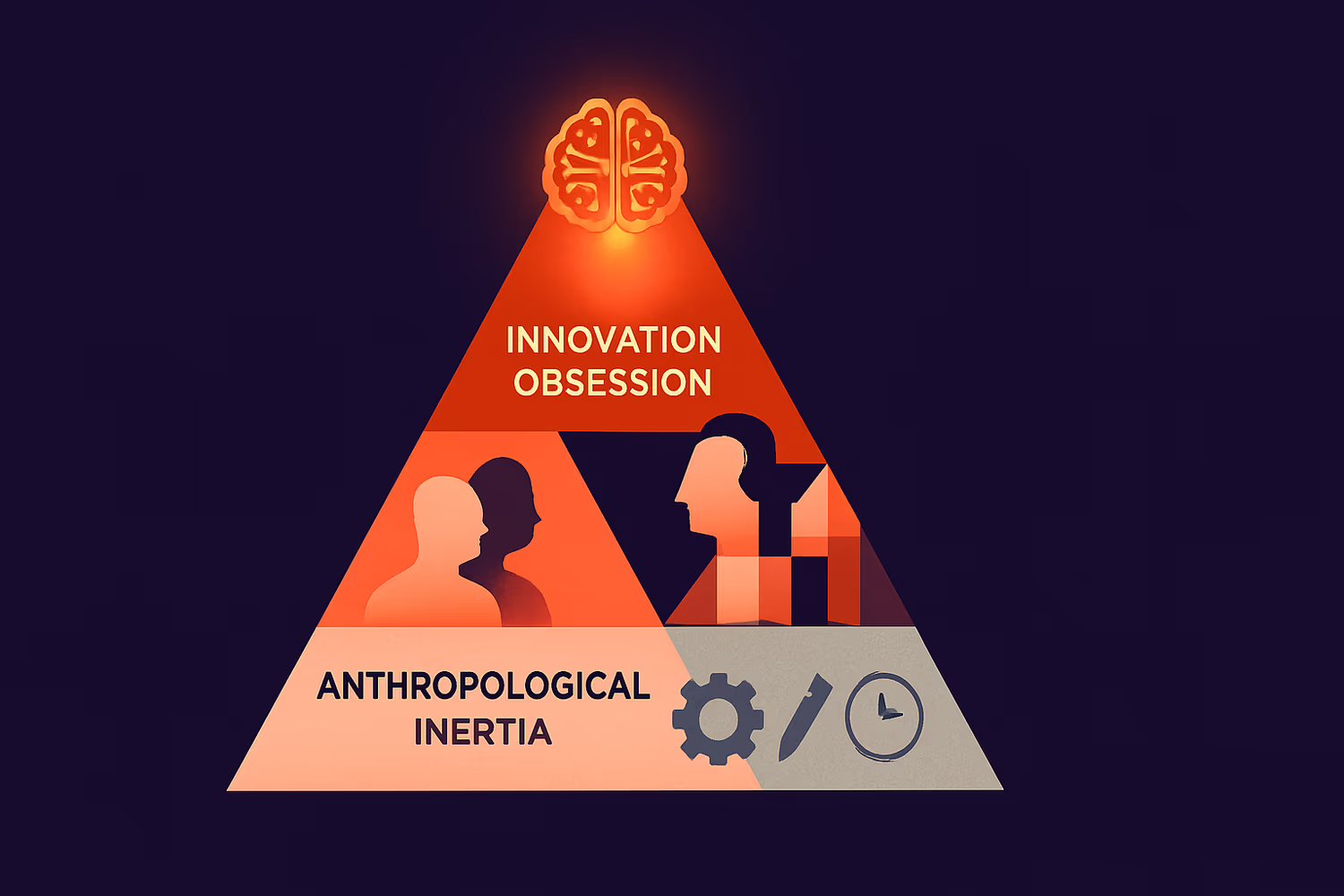I've been observing AI adoption patterns for the last two years, which, in the context of generative AI (before anybody gets too pedantic about that), is nearly its entire lifetime. The statistics emerging now shouldn't surprise anyone: 60% of AI initiatives never reach the market, and 40% of projects fail outright. The percentages vary, but they're reasonably high. We will unpick the reasons throughout this article - and they are not what you may think.
But here's what's interesting: we think this novel technology, which has literally come out of nowhere:
No one expects the Spanish Inquisition, Monty Python, 1970
Or perhaps like COVID as a better analogy — won't face adoption challenges. We are seeing similar attributes, with one significant difference in that this tech doesn't have just one attack vector.
Every SaaS platform, every business, and every person, whether in business or not, my daughter, who is at university, and everyone in between, are using this technology. That's the difference. It's everywhere, and very, very quickly.
The Triple Inertia Problem
However, that does not mean it will avoid the same adoption challenges I witnessed when we first started implementing cloud computing solutions. It may even be worse because it is so ubiquitous, so quickly.
To throw some water onto the hype fire, the statistics emerging now shouldn't surprise anyone: 60% of AI initiatives never reach the market, and 40% of projects fail outright. The percentages vary, but they're reasonably high—Gartner predicts 30% of GenAI [https://aibusiness.com/automation/gartner-predicts-30-of-generative-ai-initiatives-will-fail-by-2025]projects will be abandoned after proof of concept by the end of 2025, whilst Boston Consulting Group reports 74% of companies struggle [https://www.bcg.com/press/24october2024-ai-adoption-in-2024-74-of-companies-struggle-to-achieve-and-scale-value] to achieve and scale value from AI investments. Some academic research from MIT suggests the failure rate could be as high as 95%, spooking investors who did not read the reasons why.
It's as if we are going to simultaneously experience the Gartner Hype Cycle, not just for GenAI itself, but for every productivity tool and platform that integrates it and sells us hyped benefits. The simultaneous trough of disillusionment approaching us will be a case study in schadenfreude.
When Salesforce came out, everybody said it would never work because you need on-premises applications. It took us a long time to get over that inertia.
In business, even though AI has become almost instantly ubiquitous, it will still face what I call three layers of inertia, and these also create opportunities.
Anthropological Inertia
People are either refusing to work with AI or are not interested in doing so. I know this. I've seen it firsthand. I've seen it with my friends, colleagues, people I've worked with, and people I've talked to. Human resistance is real, and the Silicon Valley bubble does not fully comprehend it. BCG's research identifies what they call a 'silicon ceiling', only 50% of frontline employees use AI tools despite widespread availability, with middle management showing the highest resistance levels. That last bit should surprise no one.
You are not giving someone a hammer and saying, 'Hey, use this; it's better than that stone.'
The current pitch, which is wrong, is: "Hey, use this tool, it will learn from you and become as good as you at most economically valuable work. Makes zero sense to most of us.
Institutional Inertia
Just because this technology has huge and excellent capabilities does not mean that an institution looking to adopt it is suddenly any better at using and embracing technology than it was when it was implementing, let's say, a new productivity SaaS solution. Change management research consistently finds that 70% of change initiatives fail due to ineffective implementation, and AI adoption is proving to be no exception.
If you were no good at adopting new technology when it was called a CRM system, Marketing Automation, or some other SaaS platform. You're not going to be much better at adopting this, which almost certainly requires a wholesale reimagining of every process you have.
It's not going to happen - not anytime soon anyway.
BCG's research reveals the breakdown clearly: 70% of AI failures stem from people and process problems, 20% from technology challenges, and only 10% from AI algorithm limitations. The technology isn't the issue, the human side is.
Innovation Obsession
The final thing I'm observing is a tremendous amount of effort going into the disruption and innovation side—new business models, new ways of working, and how it's all going to be different. Just give me three words, and I will create content that's sure to go viral. That sort of thing.
Some of the innovations, like mud on a wall, will stick. I have no doubt. Some people will crack the occasional nut reasonably quickly. But the majority of us won't.
Here is not where the majority of us will be 'Winning with AI'.
By focusing on that part of the AI triangle (more on that later), you're missing the obvious.
The Email Marketing Lesson
I used to say this when I was working on implementing software solutions, such as email marketing suites or CRMs, etc. There was very little point in buying an email marketing suite with a vast array of sophisticated features—such as conditional blocks that change depending on the person's profile and so on—if your audience acquisition team just wants to send out single email blasts.
That functionality requires a whole culture change, not to mention data integrity.
The technology doesn't drive adoption; rather, it's the human capacity to use it differently that does. As one of my connections said [link to James podcast], if your team can't spin up the SaaS solution and do what they do now without training, it won't work.
Three-quarters of companies have yet to unlock value from AI. Too many lagging companies make the mistake of prioritising the technical issues over the human ones" Amanda Luther BCG
Let me introduce you to what I call the HITL AI Triangle.
.avif)
Personal Productivity is The Foundation
For businesses looking to adopt AI, the best place to start is, I believe, with personal productivity. I've seen it myself in my ongoing Human In The Loop Experiment. If you focus on personal productivity, which is the foundation of everything else related to AI, such as business productivity or business models enabled by AI, you can quickly start building skills and familiarity with this tool.
Your talent can start to see how they could innovate, augment, or change the business process from the old way to a new one. The AI way. Like 'talking an article to life' versus the old way, which was... well, we all know what the old ways were.
By doubling down on personal productivity, you're already winning. In fact, it's the one area where I am seeing very few adverse outcomes. Most people are saying, 'Hey, I'm getting way more done in a day than I ever used to. I've now got time.' The research backs this up: MIT's study of 444 professionals found a 40% reduction in task completion time with 18% improvement in output quality, whilst Microsoft reports 70% of Copilot users experienced increased productivity.

The Time Dividend Question
The important thing for an individual and a business to ask is What do you choose to do with that time?
If you're at work and suddenly have more time, or if you're in a small business where time stress is a huge issue, you've got some slack. And by the way, going to the gym more or leaving on time is an acceptable answer because people under pressure do not think faster.
As a business, you create a different narrative, highlighting the benefits of a collaborative approach to AI rather than a displacement one.
Now, you can start looking at the business productivity side of AI. By focusing on personal and business productivity, you could stumble upon or hit AI business models that disrupt and create value. You will definitely be ready to adapt if they happen to you, and you can react with preparedness.
From my observations focusing on AI business model innovation, particularly for small to medium businesses and asking, 'How is this going to change everything?' is a doomed approach you cannot afford. As a business leader, you will intrinsically be asking those questions, but it should not be your adoption focus.
Research validates this: gradual, bottom-up AI implementation succeeds at 67% rates versus 33% for big-bang approaches. McKinsey found that companies using gradual approaches are 3x more likely to see EBIT impact.
The Human in the Loop Realisation
The other vital realisation I've made, and it is a belief, is that our approach to adopting AI needs to include the human in the loop. We are at the centre of all of this - whether we like it or not.
I do think that the Silicon Valley executives underestimate the human and anthropological inertia around this. Just because AI can do a job, humans are still better placed to do the work in terms of eventual outcomes.
There is a lesson here from my personal experience: the effectiveness of HITL varies by task type. Decision tasks are more in the 'AI wheelhouse,' whereas I found that creative tasks are where the collaboration is most effective. MIT research supports this observation, showing dramatic variations by task type.

The Content Creation Example
If you look at content creation, it will change. You can now get deep research from any answer engine like Perplexity, ChatGPT Research, Claude Research, just type in your brief, and in the B2B context, you'll probably get something that was as well, if not better researched, than things that you were putting out in the past.
But here's where it gets interesting: Terakeet's comprehensive analysis found that AI-generated content consistently underperforms human-written content across quality dimensions—formulaic writing, tone misalignment, factual inaccuracies, and poor SEO performance. The research capability is there, but the human secret sauce still matters for quality outcomes.
If your content creators are released from some of the cognitive load of doing all that research and other repetitive tasks, what can we put on top of that content that makes it different? Which AI cannot?
That is why I genuinely believe that human-in-the-loop is the only, let's call it philosophical, way of thinking about AI adoption.
The HITL AI Triangle Framework
While I am still developing the approach by testing it on myself and creating a business with it from scratch, the last time I will do that. (That is the promise I have made to myself anyway.)
The triangle starts with personal productivity, so I have put it at the bottom. It's the foundation of everything. It is how we, as intelligent humans, will learn to work with these systems and make them work for us. They are still tools. That's all they are.
In the same way that as a manager you have managed teams, it's the same thing. It will also be the most annoying 'team member' you have ever managed because, despite the analogy, it is not a team member.
Once you've figured all that out, you can tackle your business processes or complete those two tasks in parallel, building towards preparedness for the AI business models we don't yet know about.
There is a reason I have put AI Business Processes next and on the left-hand side of the triangle, because they will require more of the left side of your brain. Additionally, these are things you can actively control and refine.
For that reason, I placed AI Business Models on the right-hand side because creating them will require a lot of mental effort on that side of the brain.
Your business will, however, build considerable resiliency in the meantime by leveraging AI to enhance personal productivity and business processes. Doing things better is a viable strategy; look at the Japanese car industry and the Kaizen approach adopted by Toyota.
AI Business Models
I once read a brilliant quote:
if you're looking to start a business, don't look at what Amazon is now, look at what Amazon was 30 years ago.
That is true.
For us to work and maximise AI as a technology and even come close to creating 'AI Business Models', we need to look back to the internet when it first started and really ask: what happened there? In fact, look at anything when it first started because the clues lie there.

I was part of the first media and events businesses to be hit by the internet. We were working in a business where we were among the first media event companies to start selling online sponsorships. No one else was doing it, or very few, rather. Look at where all of that has gone.
We also published enterprise software directories, distributing them to event attendees as an incentive and selling them afterwards. Look at where all of that has gone.
The stakes for getting this right are real. Looking back, 88% of Fortune 500 companies from 1955 disappeared by 2016 due to failure to adapt to technological changes, while more than half of Fortune 500 companies from 2000 no longer exist, primarily due to digital disruption.
Setting the foundations for working with AI around personal and business productivity will build resilience into your enterprise. While this wave of tech has unique disruption and adoption characteristics, echoes from the past are there to see.
We must explore
Exploring this AI opportunity by revisiting our experience and adopting an uncultured mindset is the way to do it. Actually, because it's novel, some of those old ideas that were previously discarded or put on the back burner may now be viable.
In fact, the novel nature of this technology creates the biggest opportunity. The current Gorillas in the market may well face the most institutional inertia. It's already happening. Look at the audacity of Perplexity offering 34Bn to Google for Chrome stunt or not. Had that happened two years ago, everyone would have laughed. Now we are not surprised.
Don't shy from it, because one of the other things that happened with the internet, and this is no word of a lie, I was working in a business where the owners said no one's going to have Internet connection because we believe it will distract you from work, and it was expensive over £5,000 per year - how rediculous are both of those notions looking back not.
Internet business adoption required 15-20 years to reach mainstream penetration (1995-2010). Cloud computing took a full decade from 2005-2015.
We always overestimate the change that will occur in the next two years and underestimate the change that will occur in the next ten - Bill Gates
AI will follow similar patterns.
I end with one piece of advice: if you're not already doing this and you are a business owner, stop worrying about all the noise. Jump onto one of the business plans of either OpenAI or Anthropic, give it to your employees, and watch what happens. Holiday Extras did precisely this, adopting a central strategy combined with local rollout, with employee word-of-mouth as the primary adoption driver, and 70% of users reported increased productivity.



